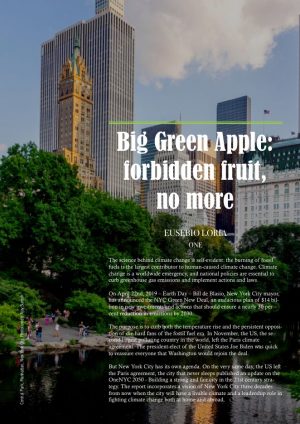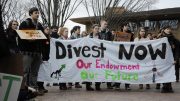 The science behind climate change is self-evident: the burning of fossil fuels is the largest contributor to human-caused climate change. Climate change is a worldwide emergency, and national policies are essential to curb greenhouse gas emissions and implement actions and laws.
The science behind climate change is self-evident: the burning of fossil fuels is the largest contributor to human-caused climate change. Climate change is a worldwide emergency, and national policies are essential to curb greenhouse gas emissions and implement actions and laws.
On April 22nd, 2019 – Earth Day – Bill de Blasio, New York City mayor, has announced the NYC Green New Deal, an audacious plan of $14 billion in new investments and actions that should ensure a nearly 30 per cent reduction in emissions by 2030.
The purpose is to curb both the temperature rise and the persistent opposition of die-hard fans of the fossil fuel era. In November, the US, the second-largest polluting country in the world, left the Paris climate agreement. The president-elect of the United States Joe Biden was quick to reassure everyone that Washington would rejoin the deal.
But New York City has its own agenda. On the very same day, the US left the Paris agreement, the city that never sleeps published an update on the OneNYC 2050 – Building a strong and fair city in the 21st century strategy. The report incorporates a vision of New York City three decades from now when the city will have a livable climate and a leadership role in fighting climate change both at home and abroad.
The launch of the OneNYC strategy in 2015 highlighted the link between climate action and inclusive growth through the introduction of equity into the city’s long-term planning. Tackling climate change requires a new social agreement to invest in communities, promote an inclusive economy, support human rights defence, public health and economic prosperity for all citizens. The NYC multifaceted strategy for action is ambitious and far-reaching. It aims to achieve carbon neutrality by 2050 in an equitable way, encompassing several sectors: buildings, transport, energy, communications, water, wastewater, and waste management.
This strategy is an investment against the real threat of rising temperatures and flooding, which threaten the city’s livability. In the US and in New York too, extreme heat is the number one cause of mortality related to weather conditions. Destructive storms are also dangerous: in 2012, Hurricane Sandy killed 44 people and caused $19 billion in damages. Unfortunately, extreme weather events are likely to happen more frequently. In 2018, the United Nations Intergovernmental Panel on Climate Change (IPCC) concluded that the world has as few as 12 years to keep the global temperature rise under the 1.5 degrees Celsius limit. Beyond this level of warming, the impact of climate change could be catastrophic and irreversible.
On the world’s current trajectory, by the 2050s NYC will see average temperatures increase by up to 3.2 degrees Celsius. Even though NYC already has a smaller per-capita carbon footprint than any big city in the United States, the release of 1.5°C: Aligning New York City with the Paris Climate Agreement (2017), provided a plan to reach carbon neutrality – 100 per cent clean electricity resources. Key passages included the complete electrification of the city and the ban of inefficient all-glass buildings. At the time of writing, these measures are in place in more than 1600 municipal buildings. The Retrofit Accelerator and Community Retrofit programs supported the complete energy retrofit of nearly 5000 privately-owned buildings.
The city also runs the largest electric municipal fleet in the nation, with more than 1750 electric vehicles (EVs), and is on track to meet the Clean Fleet goal of 2000 EVs by 2025. New York has also experienced significant growth in solar power – since the beginning of 2014, installed solar capacity has increased sevenfold.
Not only has NYC reduced emissions, but it is also now safer and more resilient, which is crucial to face the challenges ahead for the most influential metropolis of the planet. By 2050, the world’s urban population will increase by 2.5 billion people. And 60% of the buildings that will exist in 2050 have not been built yet. By 2060, the total floor area of buildings will double, with most of this new construction expected in Asia and Africa. New York must lead by example. Nearly two-thirds of the industry’s emissions are associated with the production and delivery of building materials – cement, steel, and a range of petrochemical-based and rubber materials. Despite the adoption of lower-carbon fuels, the substitution of cement clinker and the application of carbon capture and storage in materials production, emissions from the industry sector will keep growing.
Buildings and infrastructure is the largest category identified when accounting for cumulative emissions between 2017 and 2050. We need to re-think how to build facilities and infrastructure. A whole-life-cycle approach encompasses building and infrastructure construction from planning to deconstruction. It includes interaction with the entire value chain, including investors, developers, policymakers, communities, designers, engineers and material manufacturers.
“The number one cause [of greenhouse gases] in this city is the buildings,” said De Blasio. Implementing efficiency retrofits would immediately reduce multifamily energy use by 11%. Multifamily buildings emit nearly 30% of the whole building sector’s greenhouse gases. Upgrading this essential part of NYC’s structure will not only lower bills and harmful emissions but will also improve indoor health, comfort and well-being.
Energy auditors have assessed opportunities for building efficiency upgrades through packages of energy conservation measures (ECMs) to lower utility bills, improve living spaces and enable building decision-makers to understand the retrofit options better.
In 2019 NYC Council voted on the Climate Mobilization Act that includes the renovation of large and medium-sized buildings to reduce their emissions 40% by 2030 and 80% by 2050. Besides, the Climate Mobilization Act challenges the city to replace in-city gas-fired power plants with 500 MW battery storage systems powered by renewable sources (solar, wind and hydropower) and installation of green roofs on new residential and commercial buildings.
New York City’s policy recognizes the connection between environmental and economic justice. With OneNYC 2050, New York became the first town to map its local strategy according to the Sustainable Development Goals (SDGs) and to submit a Voluntary Local Review to the United Nations. Reviving the city is a challenge within a challenge. Despite the spread of the virus, New York is leading the way in addressing the climate crisis.
Eusebio Loria


